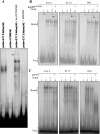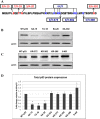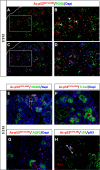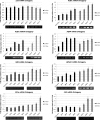Mechanisms of p53 activation and physiological relevance in the developing kidney
- PMID: 22237799
- PMCID: PMC3330719
- DOI: 10.1152/ajprenal.00642.2011
Mechanisms of p53 activation and physiological relevance in the developing kidney
Abstract
The tumor suppressor protein p53 is a short-lived transcription factor due to Mdm2-mediated proteosomal degradation. In response to genotoxic stress, p53 is stabilized via posttranslational modifications which prevent Mdm2 binding. p53 activation results in cell cycle arrest and apoptosis. We previously reported that tight regulation of p53 activity is an absolute requirement for normal nephron differentiation (Hilliard S, Aboudehen K, Yao X, El-Dahr SS Dev Biol 353: 354-366, 2011). However, the mechanisms of p53 activation in the developing kidney are unknown. We show here that metanephric p53 is phosphorylated and acetylated on key serine and lysine residues, respectively, in a temporal profile which correlates with the maturational changes in total p53 levels and DNA-binding activity. Site-directed mutagenesis revealed a differential role for these posttranslational modifications in mediating p53 stability and transcriptional regulation of renal function genes (RFGs). Section immunofluorescence also revealed that p53 modifications confer the protein with specific spatiotemporal expression patterns. For example, phos-p53(S392) is enriched in maturing proximal tubular epithelial cells, whereas acetyl-p53(K373/K382/K386) are expressed in nephron progenitors. Functionally, p53 occupancy of RFG promoters is enhanced at the onset of tubular differentiation, and p53 loss or gain of function indicates that p53 is necessary but not sufficient for RFG expression. We conclude that posttranslational modifications are important determinants of p53 stability and physiological functions in the developing kidney. We speculate that the stress/hypoxia of the embryonic microenvironment may provide the stimulus for p53 activation in the developing kidney.
Figures










Similar articles
-
Acetylation of p53 at lysine 373/382 by the histone deacetylase inhibitor depsipeptide induces expression of p21(Waf1/Cip1).Mol Cell Biol. 2006 Apr;26(7):2782-90. doi: 10.1128/MCB.26.7.2782-2790.2006. Mol Cell Biol. 2006. PMID: 16537920 Free PMC article.
-
Distinct p53 acetylation cassettes differentially influence gene-expression patterns and cell fate.J Cell Biol. 2006 May 22;173(4):533-44. doi: 10.1083/jcb.200512059. J Cell Biol. 2006. PMID: 16717128 Free PMC article.
-
A role for p53 in terminal epithelial cell differentiation.J Clin Invest. 2002 Apr;109(8):1021-30. doi: 10.1172/JCI13972. J Clin Invest. 2002. PMID: 11956239 Free PMC article.
-
Signaling to p53: breaking the posttranslational modification code.Pathol Biol (Paris). 2000 Apr;48(3):227-45. Pathol Biol (Paris). 2000. PMID: 10858956 Review.
-
Post-translational modifications and activation of p53 by genotoxic stresses.Eur J Biochem. 2001 May;268(10):2764-72. doi: 10.1046/j.1432-1327.2001.02225.x. Eur J Biochem. 2001. PMID: 11358490 Review.
Cited by
-
Editor's Highlight: Hydroxyurea Exposure Activates the P53 Signaling Pathway in Murine Organogenesis-Stage Embryos.Toxicol Sci. 2016 Aug;152(2):297-308. doi: 10.1093/toxsci/kfw089. Epub 2016 May 13. Toxicol Sci. 2016. PMID: 27208086 Free PMC article.
-
Renal progenitors and childhood: from development to disorders.Pediatr Nephrol. 2014 Apr;29(4):711-9. doi: 10.1007/s00467-013-2686-2. Epub 2014 Jan 4. Pediatr Nephrol. 2014. PMID: 24389601 Review.
-
Silencing CCNG1 protects MPC-5 cells from high glucose-induced proliferation-inhibition and apoptosis-promotion via MDM2/p53 signaling pathway.Int Urol Nephrol. 2020 Mar;52(3):581-593. doi: 10.1007/s11255-020-02383-4. Epub 2020 Feb 3. Int Urol Nephrol. 2020. PMID: 32016904
-
The MDM2-p53 pathway: multiple roles in kidney development.Pediatr Nephrol. 2014 Apr;29(4):621-7. doi: 10.1007/s00467-013-2629-y. Pediatr Nephrol. 2014. PMID: 24077661 Free PMC article. Review.
-
In situ histone landscape of nephrogenesis.Epigenetics. 2014 Feb;9(2):222-35. doi: 10.4161/epi.26793. Epub 2013 Oct 29. Epigenetics. 2014. PMID: 24169366 Free PMC article.
References
-
- Amariglio F, Tchang F, Prioleau MN, Soussi T, Cibert C, Mechali M. A functional analysis of p53 during early development of Xenopus laevis. Oncogene 15: 2191– 2199, 1997 - PubMed
-
- Armstrong JF, Kaufman MH, Harrison DJ, Clarke AR. High-frequency developmental abnormalities in p53-deficient mice. Curr Biol 5: 931– 936, 1995 - PubMed
-
- Attardi LD, DePinho RA. Conquering the complexity of p53. Nat Genet 36: 7– 8, 2004 - PubMed
-
- Barlev NA, Liu L, Chehab NH, Mansfield K, Harris KG, Halazonetis TD, Berger SL. Acetylation of p53 activates transcription through recruitment of coactivators/histone acetyltransferases. Mol Cell 8: 1243– 1254, 2001 - PubMed
Publication types
MeSH terms
Substances
Grants and funding
LinkOut - more resources
Full Text Sources
Molecular Biology Databases
Research Materials
Miscellaneous

